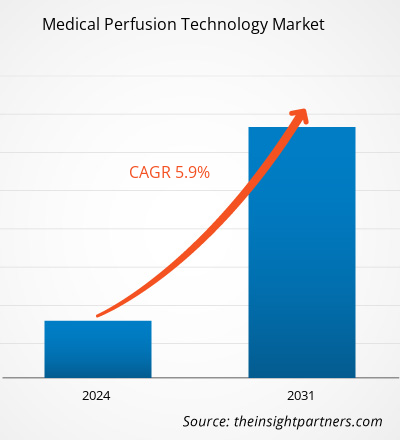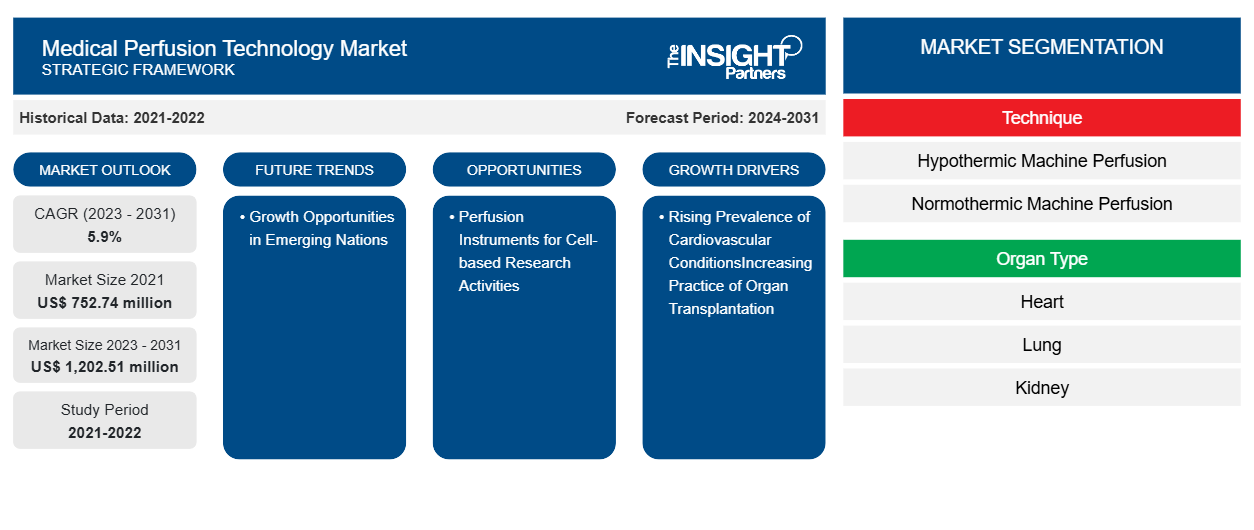La dimensione del mercato della tecnologia di perfusione medica nel 2021 era di 752,74 milioni di dollari USA e si prevede che raggiungerà 1.202,51 milioni di dollari USA entro il 2031 da XX milioni di dollari USA nel 2023. Si prevede che il mercato registrerà un CAGR del 5,9% nel 2023-2031. Gli strumenti di perfusione per le attività di ricerca basate sulle cellule e l'adozione di macchine di perfusione compatte e portatili rimarranno probabilmente le principali tendenze del mercato della tecnologia di perfusione medica.
Analisi del mercato della tecnologia di perfusione medica
La crescente prevalenza di malattie cardiache come la coronaropatia, le malattie cardiovascolari, le malattie cerebrovascolari e le malattie cardiache reumatiche, così come la significativa crescita delle aziende biotecnologiche e farmaceutiche, l'aumento delle attività di ricerca basate sulle cellule e la pratica del trapianto di organi, contribuiscono tutti alla crescita del mercato della tecnologia di perfusione medica. Inoltre, il consolidato settore sanitario, i maggiori investimenti da parte di attori chiave e i tentativi del governo di sviluppare il settore sanitario sono tutti destinati ad alimentare la crescita del mercato.
Panoramica del mercato della tecnologia di perfusione medica
Si prevede che gli Stati Uniti saranno il più grande mercato per la tecnologia di perfusione medica, il mercato è attribuito a molteplici fattori come l'aumento delle malattie cardiovascolari, la ricerca clinica completa, la ricerca a contratto e altro ancora. Inoltre, in termini di tecnologia, la nazione è molto più avanti rispetto ad altri paesi sviluppati ed emergenti. I progressi nella tecnologia hanno portato allo sviluppo di varie tecnologie di perfusione medica e tecnologie che vengono utilizzate per le loro applicazioni. Le malattie cardiache sono la prima causa di morte negli Stati Uniti. La malattia coronarica si verifica quando le arterie del cuore non sono in grado di fornire abbastanza sangue ricco di ossigeno al cuore. Secondo il CDC, il tipo più frequente di malattia cardiaca è la malattia coronarica (CAD), nel 2021, negli Stati Uniti sono morte circa 375.000 persone.
Personalizza questo report in base alle tue esigenze
Riceverai la personalizzazione gratuita di qualsiasi report, comprese parti di questo report, o analisi a livello nazionale, pacchetto dati Excel, oltre a usufruire di grandi offerte e sconti per start-up e università
-
Scopri le principali tendenze di mercato in questo rapporto.Questo campione GRATUITO includerà analisi di dati che spaziano dalle tendenze di mercato alle stime e alle previsioni.
Driver e opportunità del mercato della tecnologia di perfusione medica
La crescente prevalenza di patologie cardiovascolari favorisce la crescita del mercato
Le malattie cardiovascolari (CVD) sono disturbi correlati ai vasi sanguigni e al cuore, che includono malattie cerebrovascolari, cardiopatia reumatica e coronaropatia (CHD). Le CVD sono la principale causa di morte a livello globale. L'alterazione strutturale e funzionale dei vasi si riscontra principalmente nelle persone anziane, il che comporta il rischio di malattie cardiovascolari . Secondo i Centers of Disease Control and Prevention (CDC) nel 2020, le malattie cardiache causano la morte di circa 695.000 persone negli Stati Uniti ogni anno. Inoltre, secondo l'OMS nel 2020, a livello globale circa 17,9 milioni di persone muoiono a causa di malattie cardiovascolari. Inoltre, la maggior parte dei decessi per CVD è dovuta alla CHD, seguita da ictus e insufficienza cardiaca.
Opportunità di crescita nei paesi emergenti
Le regioni emergenti come Asia Pacifico, Medio Oriente e Africa e America Latina stanno crescendo in modo significativo nei settori biotecnologico e farmaceutico. I governi dei paesi di queste regioni stanno supportando attraverso diverse iniziative, programmi, finanziamenti e conferenze. La crescita del settore farmaceutico e biotecnologico è guidata dallo sviluppo economico e demografico, dall'aumento delle spese sanitarie e dal miglioramento dei finanziamenti sanitari pubblico-privati, tra gli altri.
Le regioni stanno assistendo a un numero crescente di aziende start-up che aiutano nella produzione di farmaci generici, componenti delle parti dei dispositivi medici e altro. Le attività di R&S nei settori della biotecnologia e dei prodotti farmaceutici stanno crescendo. Le economie emergenti stanno ora cercando supporto dalle nazioni sviluppate per nuove procedure e tecnologie avanzate. Inoltre, gli attori affermati si stanno rivolgendo alle nazioni emergenti per le loro espansioni poiché queste regioni hanno enormi potenzialità per offrire una crescita del mercato.
Analisi della segmentazione del rapporto di mercato sulla tecnologia di perfusione medica
I segmenti chiave che hanno contribuito alla derivazione dell'analisi di mercato della tecnologia di perfusione medica sono la tecnica, il tipo di organo e il componente.
- In base alla tecnica, il mercato della tecnologia di perfusione medica è diviso in perfusione con macchina ipotermica e perfusione con macchina normotermica. Il segmento della perfusione con macchina ipotermica ha detenuto una quota di mercato maggiore nel 2023.
- In base al tipo di organo, il mercato è segmentato in cuore, polmone, rene, fegato e altri. Il segmento renale ha detenuto la quota maggiore del mercato nel 2023.
- In termini di componenti, il mercato è suddiviso in pompe di perfusione, ossigenatori, macchine cuore-polmone, sistemi di monitoraggio, cannule e altri. Il segmento degli ossigenatori ha dominato il mercato nel 2023.
Analisi della quota di mercato della tecnologia di perfusione medica per area geografica
L'ambito geografico del rapporto sul mercato della tecnologia di perfusione medica è suddiviso principalmente in cinque regioni: Nord America, Asia Pacifico, Europa, Medio Oriente e Africa, Sud e Centro America.
Il Nord America ha dominato il mercato della tecnologia di perfusione medica. Si prevede che la crescente adozione di tecnologie di perfusione medica avanzate, i progressi tecnologici e la crescente enfasi sul miglioramento dei risultati dei trattamenti accelereranno la crescita del mercato della tecnologia di perfusione medica. Inoltre, l'aumento degli interventi chirurgici cardiovascolari in Canada e la crescente prevalenza di malattie cardiovascolari e asma a Città del Messico stimoleranno probabilmente la crescita della tecnologia di perfusione medica nella regione durante il periodo di previsione.
Approfondimenti regionali sul mercato della tecnologia di perfusione medica
Le tendenze regionali e i fattori che influenzano il mercato della tecnologia di perfusione medica durante il periodo di previsione sono stati ampiamente spiegati dagli analisti di Insight Partners. Questa sezione discute anche i segmenti e la geografia del mercato della tecnologia di perfusione medica in Nord America, Europa, Asia Pacifico, Medio Oriente e Africa e America centrale e meridionale.

- Ottieni i dati specifici regionali per il mercato della tecnologia di perfusione medica
Ambito del rapporto di mercato sulla tecnologia di perfusione medica
| Attributo del report | Dettagli |
|---|---|
| Dimensioni del mercato nel 2021 | 752,74 milioni di dollari USA |
| Dimensioni del mercato entro il 2031 | 1.202,51 milioni di dollari USA |
| CAGR globale (2023-2031) | 5,9% |
| Dati storici | 2021-2022 |
| Periodo di previsione | 2024-2031 |
| Segmenti coperti |
Per tecnica
|
| Regioni e Paesi coperti |
America del Nord
|
| Leader di mercato e profili aziendali chiave |
|
Densità degli attori del mercato della tecnologia di perfusione medica: comprendere il suo impatto sulle dinamiche aziendali
Il mercato della tecnologia di perfusione medica sta crescendo rapidamente, spinto dalla crescente domanda degli utenti finali dovuta a fattori quali l'evoluzione delle preferenze dei consumatori, i progressi tecnologici e una maggiore consapevolezza dei benefici del prodotto. Con l'aumento della domanda, le aziende stanno ampliando le loro offerte, innovando per soddisfare le esigenze dei consumatori e capitalizzando sulle tendenze emergenti, il che alimenta ulteriormente la crescita del mercato.
La densità degli operatori di mercato si riferisce alla distribuzione di aziende o società che operano in un particolare mercato o settore. Indica quanti concorrenti (operatori di mercato) sono presenti in un dato spazio di mercato in relazione alle sue dimensioni o al valore di mercato totale.
Le principali aziende che operano nel mercato della tecnologia di perfusione medica sono:
- Società a responsabilità limitata Getinge AB,
- Medtronica,
- Società per azioni LivaNova PLC,
- Perfusione XVIVO,
- Terumo Sistemi Cardiovascolari Corporation,
- OrganOx limitata,
Disclaimer : le aziende elencate sopra non sono classificate secondo un ordine particolare.

- Ottieni una panoramica dei principali attori del mercato della tecnologia di perfusione medica
Notizie di mercato e sviluppi recenti sulla tecnologia di perfusione medica
Il mercato della tecnologia di perfusione medica viene valutato raccogliendo dati qualitativi e quantitativi post-ricerca primaria e secondaria, che includono importanti pubblicazioni aziendali, dati di associazioni e database. Di seguito è riportato un elenco degli sviluppi nel mercato della tecnologia di perfusione medica:
- XVIVO Perfusion AB ha completato l'acquisizione di tutte le azioni della società olandese di tecnologia medica Organ Assist BV Organ Assist BV Organ Assist si concentra principalmente sullo sviluppo di macchine e materiali di consumo per la perfusione di fegato e reni. Attraverso l'acquisizione, XVIVO diventa la prima azienda al mondo, nell'ambito della conservazione e valutazione degli organi, a condurre attivamente affari in tutte le principali aree degli organi. L'acquisizione accelera la strategia dell'azienda per diventare un fornitore globale di soluzioni e sistemi in tutte le principali aree degli organi. (Fonte: XVIVO, Comunicato stampa, 2020)
Copertura e risultati del rapporto sul mercato della tecnologia di perfusione medica
Il rapporto "Dimensioni e previsioni del mercato della tecnologia di perfusione medica (2021-2031)" fornisce un'analisi dettagliata del mercato che copre le seguenti aree:
- Dimensioni e previsioni del mercato a livello globale, regionale e nazionale per tutti i segmenti di mercato chiave coperti dall'ambito
- Dinamiche di mercato come fattori trainanti, vincoli e opportunità chiave
- Principali tendenze future
- Analisi dettagliata delle cinque forze PEST/Porter e SWOT
- Analisi di mercato globale e regionale che copre le principali tendenze di mercato, i principali attori, le normative e gli sviluppi recenti del mercato
- Analisi del panorama industriale e della concorrenza che copre la concentrazione del mercato, l'analisi della mappa di calore, i principali attori e gli sviluppi recenti
- Profili aziendali dettagliati
- Analisi storica (2 anni), anno base, previsione (7 anni) con CAGR
- Analisi PEST e SWOT
- Valore/volume delle dimensioni del mercato - Globale, Regionale, Nazionale
- Industria e panorama competitivo
- Set di dati Excel
Report recenti
Rapporti correlati
Testimonianze
Motivo dell'acquisto
- Processo decisionale informato
- Comprensione delle dinamiche di mercato
- Analisi competitiva
- Analisi dei clienti
- Previsioni di mercato
- Mitigazione del rischio
- Pianificazione strategica
- Giustificazione degli investimenti
- Identificazione dei mercati emergenti
- Miglioramento delle strategie di marketing
- Aumento dell'efficienza operativa
- Allineamento alle tendenze normative























 Ottieni un campione gratuito per - Mercato della tecnologia di perfusione medica
Ottieni un campione gratuito per - Mercato della tecnologia di perfusione medica